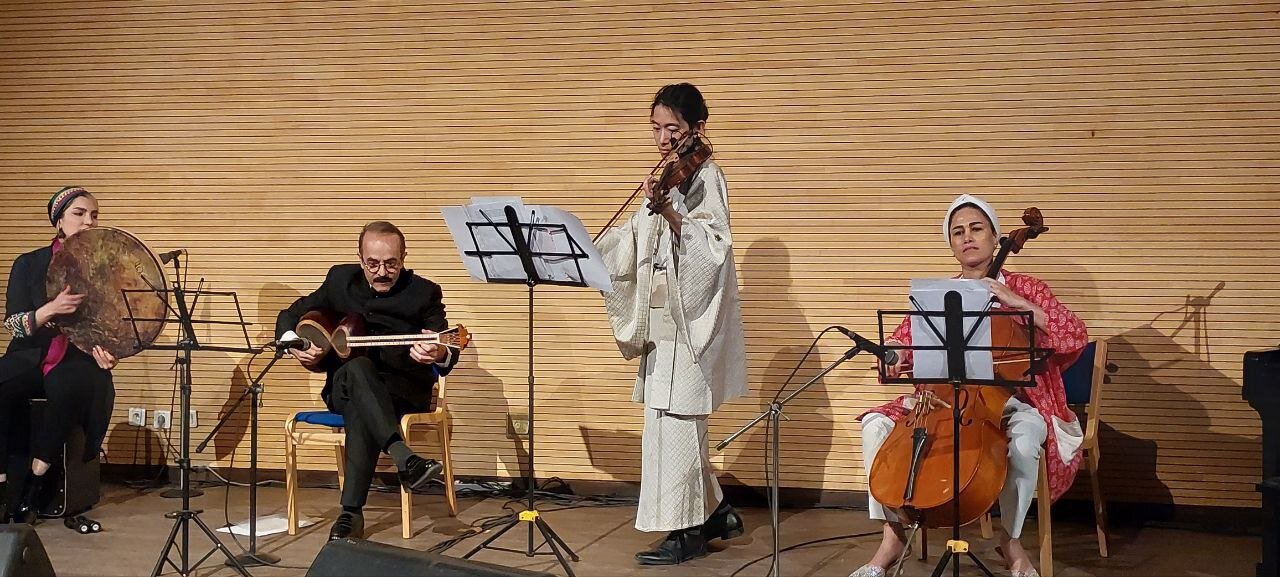“Melodies of the East” concert highlights Iran-Japan cultural ties

TEHRAN- The “Melodies of the East” concert, a cultural event featuring the collaborative artistry of renowned Iranian musician Keivan Saket and Japanese violinist Nagayo Tsumuzi, was held on Saturday at the Japan’s Embassy in Tehran.
The event, attended by foreign ambassadors and Iranian cultural officials and artists, underscored the deep-rooted cultural exchange between Iran and Japan.
The event commenced with remarks from Adachi Hideaki, the Minister Plenipotentiary of the Japanese Embassy in Iran.
Adachi emphasized the concert as a testament to the ongoing musical cooperation between the two nations, tracing the history of such exchanges back an impressive 1300 years to Japan's Nara period. He cited the presence of Iranian Sassanid artifacts, including the ancient Barbat instrument, in a collection in Nara Prefecture as historical evidence of this enduring connection via the Silk Road.
He also expressed hope for continued joint musical performances in 2029, which will mark the centenary of the establishment of diplomatic relations between Iran and Japan.
Keivan Saket, the acclaimed Iranian tar and setar virtuoso, shared his intention to perform his composition "Afsoos" (Regret). He revealed that while the piece has been performed globally with various orchestras, its performance on this occasion held particular significance.
He dedicated the musical piece to the victims of the recent tragic incident in Bandar Abbas, as well as to the victims of the historical atomic bombings of Hiroshima and Nagasaki, highlighting the shared human experience of loss and resilience.
"Given that we are all saddened by the tragic disaster in Bandar Abbas, I will dedicate this piece to the innocent victims of Bandar Abbas, as well as the victims of Hiroshima and Nagasaki."
For his part, Tsumuzi spoke about his first visit to Iran. He explained that he is in the country to record a new music video with the support of Iran’s Art Bureau of the Islamic Ideology Dissemination Organization.
Tsumuzi expressed his gratitude to the Iranian Ambassador to Japan, Peyman Sa’adat, who facilitated his trip.
Inspired by online images and the beauty of Isfahan, Tsumuzi revealed he composed a piece titled "Cloudy Isfahan," for which he is currently filming a music video. He also plans to record a video for his piece "Caravan," inspired by a desert caravanserai.
The Japanese violinist lauded the assistance of the Art Bureau and the Iranian Ambassador in fulfilling his long-held wish to visit Iran.
He also recounted his recent six-day journey with a six-person mixed Iranian and Japanese group to the cities of Tehran, Isfahan, Kashan, Varzaneh, and Shiraz.
He highlighted the successful collaboration during the video filming process, stating that the group overcame national differences to complete their work. He emphasized how the journey deepened their mutual understanding of history and culture, leading him to believe that "countries with deep history get along better," positioning Iran and Japan as potential partners due to their ancient heritage.
He also spoke of the "amazing" sense of "Japan-friendliness" he encountered, with people eager to take photos with him. This positive image and the friendly relations between the two countries were a source of pleasure, and he vowed to further expand these ties and return to experience "parallel hospitality."
The concert presented a repertoire of ten musical pieces, jointly composed by Saket and Tsumuzi. They were accompanied by a group of Iranian musicians including daf player and percussionist Negar E’zazi, tonbak player Siavash Saket, cellist Raha Sajedi, and pianist Parizad Zeyghami.
The concert concluded with a symbolic performance of the national anthem of Japan and the beloved Iranian piece “Ey Iran” (“O Iran”), highlighting the unity and friendship between the two nations through the universal language of music.
SAB/
